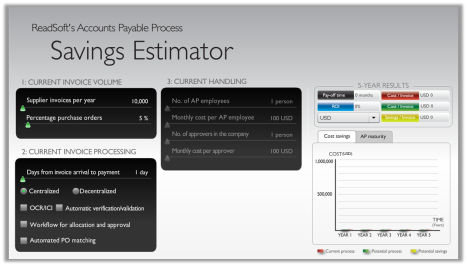UK councils currently face a total reduction of £4.7 billion in spending, which means they have to start making savings immediately, and that for many authorities means endangering frontline services.
But what if local authorities could save £80million straight away? The Audit Commission recommended local authorities facing deep cuts should review their financial planning and lessen the impact on service users by improving efficiencies. ReadSoft views automation of invoice processing in local authority finance departments as a sure fire way to improve efficiency, reduce costs and deliver better cash flow.
South Ayrshire Council is a case in point. Before it spoke to ReadSoft it was processing up to 150,000 invoices per annum. The process was decentralised with processing performed in 130+ separate sections. Each year these invoices were processed for a variety of more than 7,000 different suppliers using traditional paper-based methods. The resultant processes were labour intensive and left much room for improvement when interrogating and auditing.

South Ayrshire Council needed to modernise the Accounts Payable function in order to reduce costs and streamline processes and so turned to ReadSoft for help to not only increase the simplicity and efficiency in finance; but ensure that these procedures would become better-controlled. Today, rather than focusing on invoice processing; South Ayrshire Council is now able to concentrate on core business. Councillor Robin Reid, Portfolio Holder for Resources and Performance, says: “South Ayrshire Council is committed to achieving Best Value for our residents and realising a rapid return on our investment in ReadSoft is one way that we can be at the forefront of business transformation ensuring we meet the needs of our stakeholders and residents alike.”
Learn more about how South Ayrshire achieved this here.
For rapid reaction to the need for cuts, single tier, county and district councils can also quickly and easily deploy software as a service (SaaS) models in line with statements made by Tariq Rashad, Home Officer Lead IT Architect on the value of looking at Cloud based IT.
Local authorities can also pursue that option with ReadSoft Online, running invoice automation on an OPEX basis. That is a great way to start securing improved efficiency and really reduce costs.
To learn more about how your local authority can improve click here to download the free Local Government Efficiency Report from ReadSoft.













